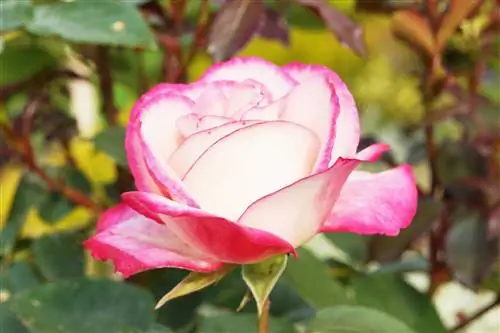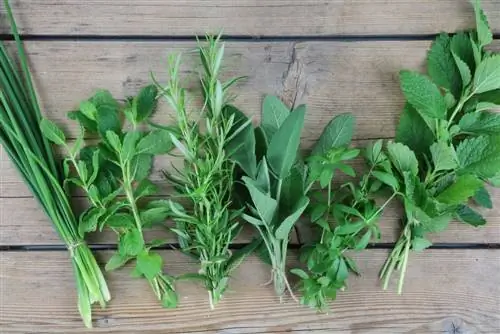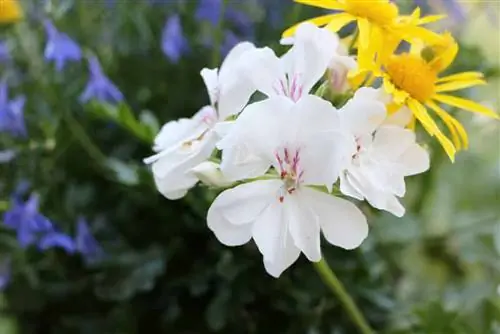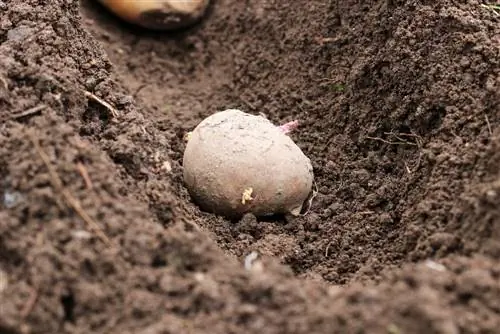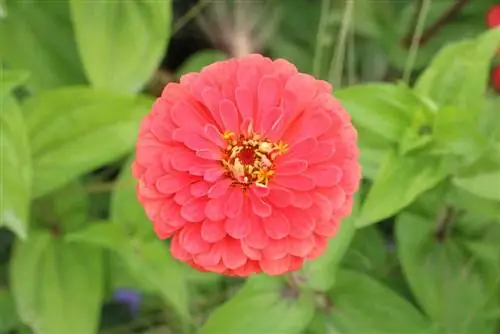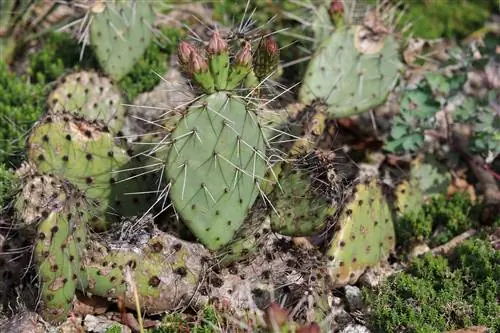- Author admin [email protected].
- Public 2023-12-17 03:39.
- Last modified 2025-06-01 06:48.
Old and popular rose varieties Even today, roses are by far the most popular plants in the gardens and around the house. Tea or noble roses alternate with polyantha and floribunda roses and there are also roses that can be used as ground cover. Standard roses, climbing roses and dog roses enrich the biodiversity and delight not only rose lovers.
Many garden owners try out as hobby growers, but most only enjoy the beautiful flowers and their intoxicating scent. People also often speak of “old roses” and “modern roses”. The difference between the two names is just a year. This means that a rose that existed before 1867 is called an old rose. All roses bred in this way are therefore modern roses. A well-known representative of the old roses is the 'Scarlachglut' from Kordes, but all noble roses can be classified in the category of modern roses. The most popular roses are the yellow 'Gloria Dei', the purple 'Charles de Mills', the 'Amaretto', 'Pomponella', the 'Cinderella' or the beautiful 'Rhapsody in Blue'. But every rose lover has their own favorites.
Buying roses is a matter of trust
If you want to have roses in your garden, you won't have to worry about sowing them, because it takes a lot of effort to grow roses from seeds. Buying container roses or roses as root-packed goods is less problematic. You can also buy the roses from a gardener or breeder, because here the rose lover can get competent advice if they wish. It is also possible to buy roses from a mail order company, but you should already know the retailer and have had good experiences.
Planting roses correctly
When can roses be planted? - The best planting time is from October to the end of April, excluding frost periods. If you plant in spring, your roses can grow safely. But the plant has to worry more about developing roots than producing flowers. Roses planted in autumn do not need to form foliage and flowers, they can instead form roots.
- Before planting, the roses should be watered again: in autumn for about two hours, in spring you should put them in the water for up to ten hours.
- The roots and grafting areas should be covered with water so that the roots can soak up.
- Many roses want a sunny location, but not full sun. A partially shaded location is also optimal.
- Do not plant on the south side of house walls, as the masonry here heats up too much and gives off the heat to the roses.
- The roses cannot tolerate the heat, the flowers tend to wilt and the roses become more susceptible to diseases.
Deep, humus-rich and loose soil is the best growth basis for roses. This allows the roots to develop optimally, as rose roots grow deep down. In addition, waterlogging should not be allowed to form, which is also harmful to the plants. The soil should have a neutral to slightly alkaline pH value. And there is something else important that rose lovers should keep in mind. The soil on which roses have already been planted is unsuitable for new planting; the soil should be replaced.
Proper care of roses
Every rose lover wants their roses to be the most beautiful and to bloom the longest. However, many types of roses need to be given appropriate care so that they bloom so beautifully and for a long time. This includes that the plants are cared for regularly:
- Wilted flowers must be removed to prevent seed heads (rose hips) from forming.
- Regular pruning should not be forgotten either, as summer pruning will increase the abundance of flowers.
But how do you cut correctly? In spring you should cut out frozen and weak shoots, as well as old wood. Noble roses should be cut back to a shoot height of approx. 20 cm, but the shoots should have at least three to five eyes so that the rose can sprout well. The higher you let the shoots stand, the more eyes there have to be on the shoots. But it should be noted that more is not always a good thing. The more you cut back, the better and stronger the plant will sprout. In summer you cut back to the nearest possible eye and remove dead shoots.
However, pruning is not enough when it comes to care if you want strong and he althy plants. A handful of fertilizer should also help:
- No fertilizer should be given to new plantings.
- If you fertilize, then from mid-May and especially with a complete fertilizer.
- You can fertilize until the second half of July, after which you should stop fertilizing.
- Only in late autumn or early winter can you use phosphorus and potassium to help the plants get off to a good start next spring.
- You can fertilize with nitrogen from March to the beginning of June to help the roses grow well.
And the roses need water too. It is important to remember that it is better to soak the soil so that the deep roots can absorb the water. Superficial irrigation does not do much good for the plants.
When the roses are sick
Every garden lover wants to have strong and he althy roses in their garden. But despite good care, regular pruning and precise fertilizer application, the roses can still become diseased. For example, cold, damp weather can also contribute to this, as this is the breeding ground for fungi. But gray mold rot and powdery mildew are also the main rose diseases in bad weather. But roses can also get diseases in other ways, for example rose rust and black sooty mildew. If brown spots become visible on the leaves, the buds dry up and fall off, then it is probably star sooty mold. Gray powdery spots found on the leaves, flower stems and buds suggest that this is powdery mildew. But living pests also like to haunt roses, such as spider mites, rose leafhoppers, rose leaf wasps and the hated aphid. If you follow all the instructions, you will have a lot of fun with your roses.
Background knowledge about rose varieties
There are over 300 varieties of roses. Roses are shrubs from the rose family. In the West, the rose is considered the noblest of all flowers and is the symbol (red rose) of love par excellence. The roses originally come from China. Confucius (551 BC to 479 BC) first reported roses in the royal gardens of Beijing. In Germany, the first rose variety was grown by Daniel August Schwartzkopf in 1773, the Pearl of Weißenstein. The past centuries have produced countless interesting rose varieties. Unfortunately many are no longer available. It is believed that there have been over 30,000 varieties of roses to date. Gardeners divide roses into different types:
- There are old roses,
- Hybrid teas and noble roses,
- Flory roses,
- Climbing roses and rambler roses,
- Shrub roses,
- Small shrub roses and wild roses.
When it comes to rose classes, a distinction is made between wild roses and garden roses. The noble roses include almost exclusively hybrid tea roses. They are characterized by large, elegantly shaped individual flowers on strong stems. This variety is floriferous and comes in many colors.
Bedding roses have a particularly large number of small, dense inflorescences and are therefore well suited for beds and borders. There are filled and unfilled varieties. They are compact and bloom until autumn. They don't lose their flowers when it rains.
Special features of popular rose varieties
- Shrub roses grow bushy. They can grow up to three meters high and have different flower shapes. Many varieties have attractive rose hip decorations. A distinction is made between once-flowering and repeated-flowering varieties.
- Climbing roses form long annual shoots that need support and fastening. They are particularly suitable for greening pergolas and scaffolding.
- Ground-cover roses are short and grow all over the area. The height growth varies depending on the variety. They are particularly suitable for slope plants and embankments. The roses grow very densely. Only a small amount of light can reach the earth. This largely prevents weed growth.
Old or historical roses predominantly have the character of shrub roses. The breeding or selection of the varieties dates back a long time. They are usually very resistant to disease. They have interesting flower shapes and have a very strong scent. However, they lack the variety and rich blooms of modern roses.
- Wild roses are very robust. They are often used as windbreaks in the open landscape or as embankments and slopes to secure the ground.
- English roses combine the wide range of colors and long flowering times of modern rose varieties with the charm and delicate scent of old roses.
- Rambler roses form long, soft shoots and are particularly suitable for greening light trees.
More and more varieties of roses are not only blooming beautifully in the garden, they are also pleasing to the eye in pots or buckets. It should be noted that roses are deep-rooted and therefore prefer tall containers because they love a lot of soil under the roots. The advantage of these roses is that you can always create new color and scent combinations by rearranging the pots. Tall roses (rose stems) are also very popular, both in pots and in the garden. The advantage of this is that you can then plant low-growing plants as ground cover and create so many different variations.

